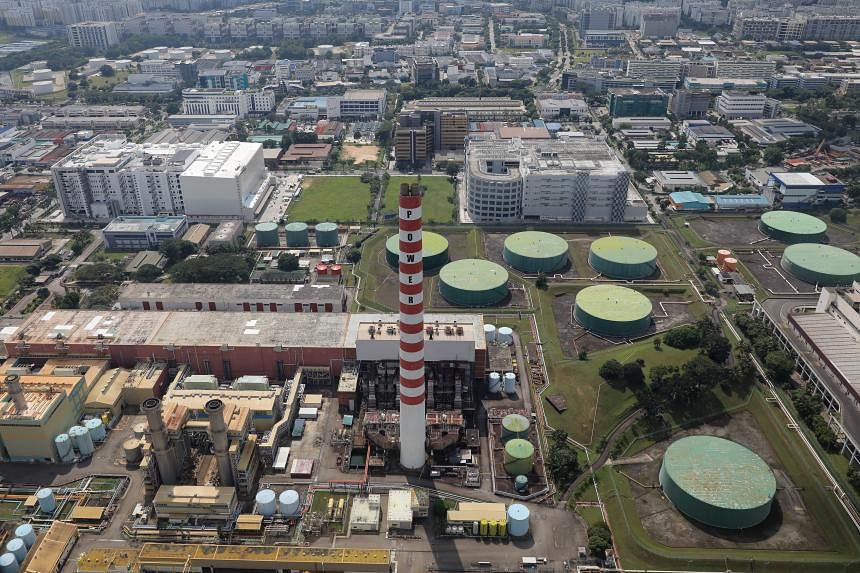SINGAPORE - Singapore’s greenhouse gas emissions in 2021 reached the highest levels yet at 57.7 million tonnes of carbon dioxide equivalent – representing around a 9 per cent increase from 2020 levels.
The National Climate Change Secretariat (NCCS) said on Friday that the increase was reflected across most sectors, due to the resumption of economic activity after the early days of Covid-19.
But emissions from the water sector decreased by 1 per cent from 2020 to 2021. These include methane emissions from wastewater sludge.
In 2020, emissions were at 52.8 million tonnes, and in 2019, it was 55.4 million tonnes.
In 2021, industrial emissions accounted for the bulk of emissions at 44.4 per cent, closely followed by the power sector, which accounted for 39.2 per cent of total emissions.
Transport was the third-largest contributor, accounting for 14.2 per cent of total emissions.
Industries also contributed the largest share of power sector emissions, followed by buildings and households.
Singapore has a long-term national climate target of reaching net-zero emissions by 2050.
In line with this, it will be reducing emissions to around 60 million tonnes in 2030 after peaking emissions earlier.
This means that Singapore’s emissions will grow to around 65 million tonnes between 2025 and 2028, before starting to fall towards the end of this decade and reaching net zero by 2050.
In response to queries from The Straits Times on whether the Government has a clearer picture of when emissions will peak, NCCS pointed to a speech made by Minister for Sustainability and the Environment Grace Fu in November 2022, saying that the Republic will peak emissions at 65 million tonnes between 2025 and 2028.
Ms Fu said in Parliament then that it was premature to announce a precise year in which emissions would peak, as peaking emissions would require substantial transformation across industries, economy and society.
Ms Melissa Low, a research fellow at the National University of Singapore’s Centre for Nature-based Climate Solutions, noted that emissions shares for most of the sectors appear to be relatively similar in 2020 and 2021, although the share of emissions from the transport sector has increased by 0.5 per cent.
“This may not be surprising as online shopping behaviours brought about by the pandemic could have resulted in an increase in logistics and transport emissions. Overall, the rest of the emissions shares looks more or less the same from 2020 to 2021,” she added.
The share of power sector emissions fell slightly from 39.8 per cent in 2020 to 39.2 per cent in 2021, which could be a result of increased solar energy deployment, she noted.
Solar deployment here has already surpassed 1 gigawatt-peak, which would mean that Singapore is now more than halfway to reaching its target of 2 gigawatt-peak by 2030.
“In terms of whether we should peak earlier, the question we should be asking is whether we can begin to decarbonise faster once we peak,” said Ms Low.
Of the 57.7 million tonnes in 2021, an estimated four million tonnes came from hydrofluorocarbon (HFC) emissions, which are synthetic gases primarily used for cooling and refrigeration.
Although HFCs currently represent around 2 per cent of total greenhouse gases worldwide, their impact on global warming could be at least a few hundred times greater than carbon dioxide.
“As the world gets warmer, Singapore may rely more on air-conditioning and refrigeration to keep food and other items cool and fresh. So if this share continues unchecked, we may actually end up peaking emissions earlier,” Ms Low added.
Since Singapore started tracking greenhouse gas emissions in 1994, emissions have doubled from 26.8 million tonnes to 53.7 million tonnes in 2021 – excluding those from HFCs, she noted.
Ms Low pointed out that some of Singapore’s decarbonisation strategies have yet to see any impact on reducing emissions, such as the import of electricity, use of hydrogen as a cleaner source of power generation, the electrification of transport, or the use of carbon capture technologies.
The key question may be whether Singapore is still expecting to peak at 65 million tonnes around 2025 to 2028, or will it be sooner, given the current rate of increase in emissions.
But the spike in emissions from 2020 to 2021 may not be a good measure of Singapore’s current trajectory, since emissions had dipped due to the pandemic, then rebounded in 2021, Ms Low added.


